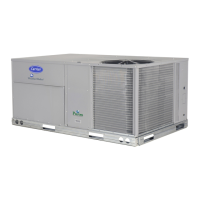41
Fig. 53 — Convenience Outlet Utilization Notice Label
(Sizes 07-14)
Using unit-mounted convenience outlets
Units with unit-mounted convenience outlet circuits will often
require that two disconnects be opened to de-energize all pow-
er to the unit. Treat all units as electrically energized until the
convenience outlet power is also checked and de-energization
is confirmed. Observe National Electrical Code Article 210,
Branch Circuits, for use of convenience outlets.
Factory Option Thru-Base Connections
This service connection kit consists of a
1
/
2
-in. electrical bulk-
head connector and a 1
1
/
4
-in. electrical bulkhead connector, all
factory-installed in the embossed (raised) section of the unit
basepan in the condenser section. The
1
/
2
-in. bulkhead connec-
tor enables the low-voltage control wires to pass through the
basepan. The 1
1
/
4
-in. electrical bulkhead connector allows the
high-voltage power wires to pass through the basepan. See
Fig. 54 and 55.
Fig. 54 — Thru-Base Connection Fittings
(Size 08-14 units and 07 units built prior to 4/15/2019)
Fig. 55 — Thru-Base Connection Fittings
(Size 07 units built on or after 4/15/2019)
Check tightness of connector lock nuts before connecting elec-
trical conduits.
Field-supplied and field-installed liquid-tight conduit connec-
tors and conduit may be attached to the connectors on the base-
pan. Pull correctly-rated high voltage and low voltage through
appropriate conduits. Connect the power conduit to the internal
disconnect (if unit is so equipped) or to the external disconnect
(through unit side panel). A hole must be field-cut in the main
control box bottom on the left side so the 24-v control connec-
tions can be made. Connect the control power conduit to the
unit control box at this hole.
Units Without Thru-Base Connections
1. Install power wiring conduit through side panel openings.
Install conduit between disconnect and control box.
2. Install power lines to terminal connections as shown in
Fig. 49.
Field Control Wiring
The 50TC unit requires an external temperature control device.
This device can be a thermostat (field-supplied) or a Premier-
Link™ controller (available as factory-installed option or as
field-installed accessory, for use on a Carrier Comfort Net-
work
®
or as a stand alone control) or the RTU Open Controller
for Building Management Systems using non-CCN protocols
(RTU Open is available as a factory-installed option only).
Thermostat
Install a Carrier-approved accessory thermostat according to
installation instructions included with the accessory. For com-
plete economizer function and 2-stage compressor operation,
select a two-stage cooling thermostat. If a 2-stage cooling ther-
mostat is not available, use a single stage cooling thermostat
instead, but note that this will limit cooling to just 1 stage. Lo-
cate the thermostat accessory on a solid wall in the conditioned
space to sense average temperature in accordance with the
thermostat installation instructions.
If the thermostat contains a logic circuit requiring 24-v power,
use a thermostat cable or equivalent single leads of different
colors with minimum of seven leads. If the thermostat does not
require a 24-v source (no “C” connection required), use a ther-
mostat cable or equivalent with minimum of six leads. See
Fig. 56. Check the thermostat installation instructions for addi-
tional features which might require additional conductors in
the cable.
For wire runs up to 50 ft. (15 m), use no. 18 AWG (American
Wire Gage) insulated wire [35°C (95°F) minimum]. For 50 to
75 ft. (15 to 23 m), use no. 16 AWG insulated wire [35°C
(95°F) minimum]. For over 75 ft. (23 m), use no. 14 AWG in-
sulated wire [35°C (95°F) minimum]. All wire sizes larger than
no. 18 AWG cannot be directly connected to the thermostat and
will require a junction box and splice at the thermostat.
LOW VOLTAGE
CONDUIT
CONNECTOR
HIGH VOLTAGE
CONDUIT
CONNECTOR
LOW VOLTAGE
CONDUIT
CONNECTOR
HIGH VOLTAGE
CONDUIT
CONNECTOR
AUXILIARY
POWER SUPPLY
(OPTIONAL)

